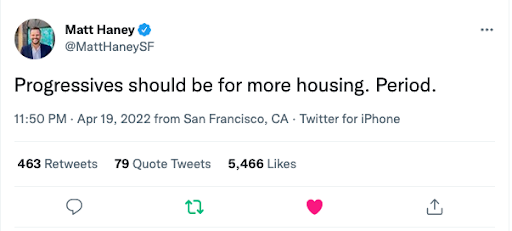The HomeWork: April 27, 2022

Welcome to the April 27, 2022 Main edition of The HomeWork, the official newsletter of California YIMBY — legislative updates, news clips, housing research and analysis, and the latest writings from the California YIMBY team.
News from Sacramento
It’s the height of the legislative season in Sacramento, with first-house policy committees wrapping up their work this week. Many of California YIMBY’s priority bills passed their first (and in some cases, second) policy committees, including:
- AB 2873 (Jones-Sawyer), which will help track the demographics of the affordable housing construction workforce
- AB 2097 (Friedman), which will remove expensive parking mandates around transit
Another California YIMBY priority bill, AB 2011 (Wicks), has emerged as high-profile housing legislation. The bill creates a ministerial process for the “by-right” approval of mixed-income housing proposed at existing commercial properties, as well as a density bonus for these projects. The bill is supported by the California Council of Carpenters, as well as several affordable housing associations.
The next step for most housing bills will be first-house appropriations committees, which will be scheduled in coming weeks. The Legislature will then pivot to finishing the budget, which by law must be completed by the middle of June. The Governor’s revised budget proposal, due in early May, will likely reflect billions of new dollars in the General Fund; Legislators and the advocacy community are likely to push for at least some of these funds to be dedicated to affordable housing and related infrastructure.
Housing Research & Analysis
Do “Area Plans” Harm Affordability? The Case for City-Wide Upzonings
Shane Phillips at the UCLA Lewis Center for Regional Policy Studies analyses the relationship between land values and upzoning in a new essay, “Building Up the ‘Zoning Buffer’: Using Broad Upzones to Increase Housing Capacity Without Increasing Land Values.” Phillips explores policy strategies for increasing housing production without major shocks to land values that can make current homeowners fear a lack of affordability.
The key concept: If zoning changes allow new multi-family homes to be built in one specific neighborhood – but, importantly, not in others – that neighborhood could see new development potential lead to spikes in land and existing home values, leading to possible displacement. But if zoning is increased broadly throughout a larger area, ideally city- or region-wide, development potential and stability would not be at odds.
Key takeaways:
- Ongoing housing shortages are exacerbated by the historic downzonings of the 1960s and 70s, in which most California cities like Los Angeles drastically reduced their capacity for new homes in order to prevent construction. By contrast, most upzonings since then have been through “area plans” and “spot zonings” that only target small, specific neighborhoods; sometimes, zoning changes are only applied to a single project or lot.
- Cities should aim for broader upzoning to create a large “zoning buffer”—the gap between the current housing stock, and maximum number of potential new homes permitted in the zoning code.
- The larger and broader this buffer, the more affordable housing can be to both new and existing residents. As Philips writes: “When zoning capacity exceeds population by a wide margin, reductions to the cost of construction will benefit people looking to buy or rent a home. When capacity exceeds population by a narrow margin, cost reductions will benefit people who own land.”
How Apartment Bans Keep Americans in the Poor House
A new literature review by Federal Reserve staff economists Jia et al (2022) assesses the evidence from the economic costs of reduced migration. In particular, the review adds context to the findings of Hsieh & Moretti (2019) that restrictions on homebuilding in just three major metros – New York, San Francisco, and San Jose – are holding back the country’s economic growth by 3.7% of Gross Domestic Product (GDP) per year.
To put this in perspective, with 1% of GDP growth estimated to lift 1.7% of a nation’s population out of poverty, over a million Americans could be lifted out of poverty by this amount of growth alone.
Key takeaways:
- Internal migration is good for economic mobility. Long-distance moves are largely associated with new employment opportunities, and people tend to move from less prosperous to more prosperous places early in their careers.
- After 2007, though, people were less likely to respond to mass layoffs with out-migration. The evidence shows that the in-migration effects of job growth are greater than the out-migration effects of unemployment, suggesting that migration doesn’t work toward an “equilibrium” between regional job markets.
- Homeownership results in less incentive to move for better jobs, but high housing prices do reduce net migration, and hinder economic growth by limiting “labor reallocation” to booming cities.
Houser Headlines
- Yimby Movement Goes Mainstream in Response to High Housing Costs
- How Green Is Your Metropolis?
- Parking mandates are a top barrier to affordable housing
- Community Input is Bad, Actually
- Is NIMBYism On The Way Out?
- California must prioritize people over parking as it approves new housing developments
- California can’t be a haven for others until it builds more housing for everyone
- State relies on activists to enforce duplex law
- Turn golf courses into housing? We’re desperate enough that it should be on the table
- Report shows LA, OC residents want more dense housing
- California Cities Could Face a Zoning Reckoning
- Angelenos are alarmed by air pollution and extreme heat. Poll finds they want action
YIMBY Social – Top Posts

Share the good word
We welcome your ideas and feedback — send story tips and ideas to Homework@cayimby.org.